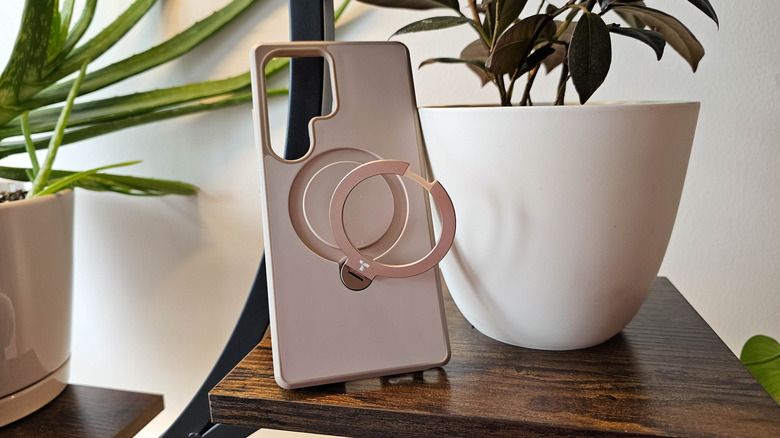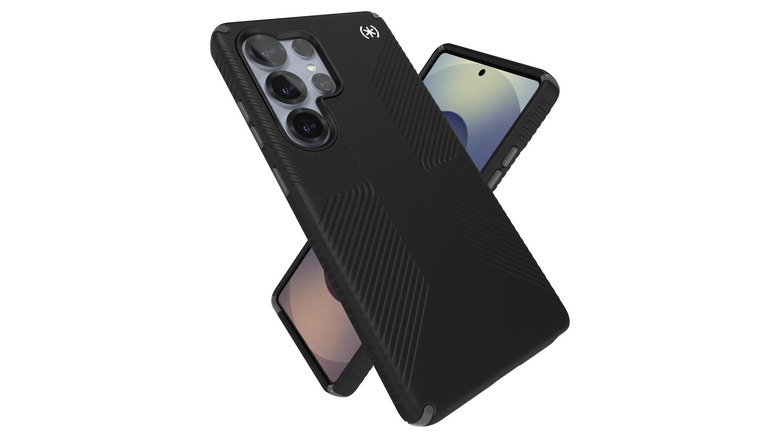Is A Cheap Phone Case Enough To Protect Your Device?
We may receive a commission on purchases made from links.
Smartphones continue to get more expensive, and the best iPhones and Samsung Galaxy devices now cost well over a thousand dollars. No matter how much a phone costs, it's the one device you'll carry with you everywhere, and it carries some of your most valuable information. The first thing most people do with a new smartphone is purchase a case to protect it.
However, major smartphone case brands have grown more expensive, too. It's not abnormal to see cases priced at $80 or more, especially for the most premium flagship phones. Are you really getting more protection for your device when you pay out the nose for a case, or are case manufacturers simply preying on consumer fears, promising additional safeguards for your prized possession while fleecing you? Is there really a downside to saving some money and opting for a bargain bin phone case?
The short answer is that you can definitely find a great case for less than you'd think, and you can also pay a lot for a case that won't offer much protection at all. Here's what you need to know about the difference between cheap and expensive phone cases in terms of keeping your phone safe.
The style and materials of your phone case matter more than its price
It's tricky to determine whether a cheap phone case will protect your device because we've seen very expensive cases with minimal protection, as well as relatively affordable cases that are much more likely to withstand a drop. What matter most are the materials and design of your phone case. For instance, this Peel iPhone case costs $35, which is not exactly cheap, yet its Amazon listing is plagued by reviews from users whose phones still shattered when dropped, even with the case. Because it is made of a rigid material and is extremely thin, it can't absorb the impact shock of a drop. In this case's defense, it doesn't advertise drop protection.
On the other hand, this $10 Supfine iPhone 16 case has thousands of five-star reviews. What gives? The case is made from thermoplastic polyurethane, or TPU, which is a common material for phone cases thanks to its superior shock absorption. Because TPU is extremely cheap, this case can still turn a profit for the manufacturer at its low price. You could even 3D print your own TPU case, since the material is a consumer grade 3D filament, though it's hard to say how durable it would be. One downside of cheap TPU is that phone cases can yellow easily when made with it.
Other cheap ways to improve protection include adding a lip to the case so that the edge of it is raised over the phone's screen. When a phone is dropped face-down on a flat surface, the lip will hit the ground rather than the screen. The same can be done on the back of the case to protect the phone's camera bumps.
Why some expensive cases can be worth it
At higher prices, case manufacturers can add some extra features to protect your phone. For example, some cases are two-shot with both a soft TPU interior and a hard outer shell. This mimics the structure of a bike helmet, with the outer shell distributing the force of a drop impact across the surface of the softer TPU, which then diffuses that energy before it can reach the fragile phone inside. You can see this design in cases like this Speck Presidio 2 Grip case, among other cases from other companies. The Speck case also adds small bubbles around the inside of the case where it will sit on the phone's rails. These gaps create a sort of air cushion, further helping to direct the shock of an impact away from the phone itself. At $40, it's four times more expensive than the $10 case we looked at earlier, but it offers a significantly better design.
Moving up in price to brands that position themselves as upscale, like Mous Case, you'll see prices jump up to $70 or more. This is where the return on investment may be a bit more dubious, and any added protection seems marginal at best. These are nice cases, to be sure, but rather than extra protection, you're more likely paying for materials like carbon fiber and wood that accent the back of these cases, which appear to be purely aesthetic.
The bottom line is that, while it can sometimes be worth paying more than the bare minimum, price is not strictly correlated with the protection a phone case will offer. Instead of considering the price tag alone, pay close attention to the materials and design of the case you choose.


